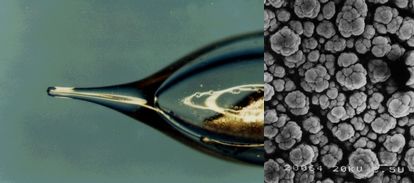Purpose
Diabetes is known to cause various complications such as diabetic retinopathy. In this study, we aimed to develop a novel blood glucose level device as an important means of controlling diabetes.
Achievements
This project had been conducted from the inception of the Department of Rehabilitation Engineering, aiming for application to small clinical laboratory testing equipment etc. As the main achievement, we developed a very small needle-shaped blood glucose sensor with a tip diameter of 1 μm - 300 μm.Porous platinum black (platinized platinum) is deposited at the tip of the sensor, so many enzymes can be immobilized here and it has a very high sensitivity despite its small size.

Figure 1. Platinum black-based blood glucose sensor (left: tip image, right: platinum black SEM image)
Apart from sensor devices, as a derivative outcome, we improved the blood glucose meter so that diabetes people with visual impairments such as diabetic retinopathy can measure the blood glucose level, by developing a voice talking module. After that, it was granted by the Techno-Aid Association as a practical project, and it was carried out with the cooperation of Matsushita Electric Industrial Co., Ltd., Matsushita Kotobuki Electric Co., Ltd., Arkray Co., Ltd., and Artronics Co. Ltd. Furthermore, the product which was further improved was commercialized from ARKRAY CO., LTD. (Trade name: PlusTalkTM).

Figure 2. PlusTalkTM
Original Papers (English)
- Y. Ikariyama, S. Yamauchi, T. Yukiashi, H. Ushioda, Micro-Enzyme Electrode Prepared on Platinized Platinum, Analytical Letters, 20(9), 1407-1416 (1987).
- Y. Ikariyama, S. Yamauchi, T. Yukiashi, H. Ushioda, One Step Fabrication of Microbiosensor Prepared by the Codeposition of Enzyme and Platinum Particles, Analytical Letters, 20(11), 1791-1801 (1987).
- Y. Ikariyama, N. Shimada, S. Yamauchi, T. Yukiashi, H. Ushioda, Pulse Voltammetric Biosensing System for the Rapid Determination of Glucose with Micro-Enzyme Sensor, Analytical Letters, 21(6), 953-964 (1988).
- Y. Ikariyama, S. Yamauchi, T. Yukiashi, H. Ushioda, Surface Control of platinized platinum as a transducer matrix for micro-enzyme electrodes, J. Electroanal. Chem., 251, 267-274 (1988).
- Y. Ikariyama, S. Yamauchi, M. Aizawa, T. Yukiashi, H. Ushioda, High Performance Micro-Enzyme Sensor Using Platinized Microelectrode, Bull. Chem. Soc. Jpn., 61, 3525-3530 (1988).
- Y. Ikariyama, S. Yamauchi, T. Yukiashi, H. Ushioda, Electrochemical Fabrication of Amperometric Microenzyme Sensor, J. Electrochem. Soc., 136(3), 702-706 (1989).
- S. Toyama, Y. Nakata, S. Yamauchi, Y. Ikariyama, Design and Characterization of Nickelocene, Pt Microparticle, and Enzyme Co-blended Glucose Sensor, DENKI KAGAKU, 63(12), 1095-1099 (1995).
- S. Toyama, Y. Chisuwa, Y. Ikariyama, Glucose Sensor Based on Nickelocene Blended Carbon Paste Electrode - Suppression of Enzyme Leaking from Electrode Surface -, IEEJ Transactions on Sensor and Micromachines, 119(11), 560-564 (1999).
- S. Toyama, Y. Ikariyama, H. Uenoyama, Y. Sato, S. Nankai, Y. Tokuno, M. Uchiyama, Blood Glucose Meter with Voice Announcing Module for Blind Patients with Diabetic Retinopathy, Asia and Pacific Journal on Disability, 3, 11-15 (2000).
- S. Toyama, M. Someya, O. Takei, T. Ohtake, R. Usami, K. Horikoshi, Y. Ikariyama, Fabrication and Characterization of Gold-Platinum Black Electrode, Chemistry Letters, 30(2), 160-161 (2001).
- O. Takei, S. Toyama, M. Someya, T. Kurokawa, R. Usami, K. Horikosi, Y. Ikariyama, Glucose Sensor Based on Au-Pt Black Electrode - Preparation of Functionally Different Sites on Electrode Surface, Electrochemistry, 69(12), 956-958 (2001).
- S. Toyama, K. Aoki, S. Kato, M. Nakamura, R. Usami, Fabrication of Electrodes for Chemical Sensors on Overhead-Transparency Film, Electrochemistry, 74(2), 128-130 (2006).
